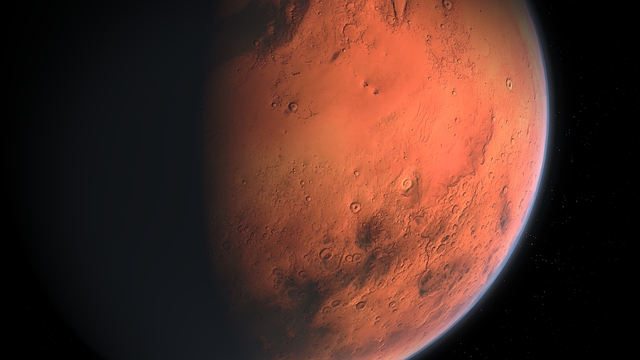By Tim Lambert
The observation of Mars
The planet Mars was named after the Roman god of war. However, it was impossible to observe any details on Mars until the telescope was invented. Galileo was the first person to turn a telescope on Mars in 1610. The telescope Galileo had was not powerful enough to discern any details of the surface. However, he did notice that Mars was not perfectly round.
In 1659, Christiaan Huygens estimated the size of Mars. He estimated it was about 60% of the size of the Earth. Huygens also estimated the rotational period of Mars was about 24 hours. He also observed a dark region on Mars called Syrtis Major. Then in 1666, Giovanni Cassini noticed a white area at the south pole of Mars. He also estimated the rotational period of Mars as 24 hours and 40 minutes.
In 1719 Giacomo Maraldi observed white areas at the poles of Mars. In 1781, William Herschel deduced that the white areas at the poles of Mars are ice caps. He also realized that Mars has seasons the same as Earth.
In 1877, Asaph Hall discovered that Mars has two small moons. He named them Phobos and Deimos. Meanwhile, in the late 19th century, some astronomers thought they saw lines on the surface of Mars. In 1877, Giovanni Schiaparelli made a map of Mars showing many such lines. He called them canali, meaning grooves. It was mistranslated into English as canals, leading many people to believe that civilization on Mars had created them. However, some astronomers denied that such lines existed.
Probes to Mars
The next step in exploring Mars came in the late 20th century when automatic probes were sent. In 1964, the Americans launched Mariner 4. In July 1965, it flew past Mars. Mariner 4 returned the first detailed photos of Mars, showing many craters on its surface. Mariner 6 and Mariner 7 sent back more photos of Mars in 1969.
In 1971, Mariner 9 photographed what seemed to be dried-up riverbeds on Mars. That suggested that the atmosphere of Mars was once thicker and there was liquid water on the planet. It raised the possibility that there was once life on Mars.
The Americans sent probes to search for evidence of life on Mars. Two probes were sent, Viking I and Viking 2. Viking I landed in July 1976 and Viking 2 landed in September 1976. Neither found any evidence of life on Mars.
However, exploration of Mars continued apace in the late 20th century and early 21st century, and several probes were sent to the planet. Mars Global Surveyor was launched in 1996. It reached Mars in 1997. It operated for 9 years, sending its last signals in 2006.
Mars Odyssey began orbiting Mars in 2002 in a mission to map and study the planet. Then in 2004, NASA landed 2 rovers named Spirit and Opportunity on Mars. Then, in 2008, a spacecraft called Phoenix reached Mars. It was followed in 2012 by the Curiosity Rover, which landed on Mars. Then, in 2014, India sent a probe that went into orbit around Mars.
In 2021, an unmanned helicopter called Ingenuity flew on Mars. It was the first vehicle to fly on another planet.
The next big step will be to send a manned expedition to Mars. Several nations have plans to send expeditions to Mars, but none will take place before at least the 2030s.

Stories About Mars
In 1898 H G Wells published The War of the Worlds. It was not set on Mars. Instead, the technologically superior Martians invade the Earth but they are all killed by microscopic organisms.
During the 20th century, many more science fiction stories were set on Mars. In 1917 Edgar Rice Burroughs published a book called Princess of Mars. It was an adventure story in which a human finds himself on Mars. It was followed by a series of other stories set on Mars or Barsoom as the inhabitants called it.
In 1938 the writer C S Lewis wrote a book called Out of the Silent Planet. In it the hero, Ransom is kidnapped and taken to Mars. He escapes and befriends some of the inhabitants. Lewis imagined three different intelligent species living on Mars. However, Lewis realized that the atmosphere on most of Mars must be too thin to support a civilization. The only inhabited areas are deep valleys. The hero (and the villains) eventually return to Earth.
In 1950 The Martian Chronicles by Ray Bradbury was published. In these stories, a great civilization exists on Mars but the inhabitants are wiped out when they catch smallpox from human explorers. Mars is then settled by humans. In 1980 The Martian Chronicles was made into a TV series.
In 1951 Arthur C Clarke wrote The Sands of Mars. In this novel, humans plan to transform Mars to make it habitable.
Many films featured Mars or Martians. Invaders from Mars was made in 1953. The same year War of the Worlds was made into a film. In 1955 the film Conquest of Space depicted an expedition to Mars.
In Dr Who, a race called the Ice Warriors came from Mars. (They made their first appearance in 1967). In Captain Scarlet and the Mysterons, humans destroy an alien city on Mars provoking a war with a race of mysterious beings.
Last revised 2024